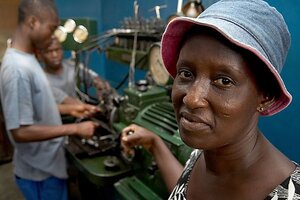Microfinance can mean a lot to the environment
Earthtalk: Little payments can jump-start a business and lead to greener communities.

Rebecca Anderson stands in the mechanic shop she co-owns in Ghana. She availed herself of a small loan to replenish inventory.
NEWSCOM
Q: What is “microfinance,” and how does it help poor countries and preserve the environment?
– Eliza Clark, Seattle
A: The brainchild of Grameen Foundation founder Muhammad Yunus, microfinance is a form of banking whereby financial institutions offer small loans to the poor. The idea behind the concept, which originated in Bangladesh in the mid-1970s, is that motivated and disciplined poor people could climb out of poverty if they had access to funding – even small amounts – that help get businesses off the ground. With access to revolving loan funds, these “micro-entrepreneurs” can build businesses, pay back the loan, and continue to provide for themselves and their families in a sustainable way.
A classic example would be a woman who borrows $50 to buy chickens so she can sell eggs. As her chickens multiply, she sells more eggs, and, later, chicks as well. As she climbs out of a perhaps desperate situation, she repays the money. The community, meanwhile, benefits from having a new source of nutritious food.
“Having access to money to start a small business isn’t about fulfilling a dream, it’s literally about keeping their families one step ahead of starvation and putting a roof over their heads,” says Tracey Turner, founder of MicroPlace, an online “microfinance marketplace” launched by eBay in 2007. Individuals can put small or large amounts of money on MicroPlace and get a rate of return in the 2- to 3-percent range – better than a donation – and gain the satisfaction of knowing that their cash is helping someone in a developing country improve his or her lot and that of a poor community.
On the environmental front, microfinance is, in and of itself, “green” in that it promotes sustainable businesses. Many examples over the last 30 years have proven the concept that when poor people are given opportunities to earn a living in a legitimate and sustainable fashion, they have little or no need to pillage their natural surroundings for food or shelter.
Most financial institutions involved in microfinance also cite sustainability as a precondition. Others encourage greener businesses by giving lower rates to borrowers with sustainability-oriented plans.
While upstarts like MicroPlace and Kiva (which operates on a similar model in which investors can participate) are grabbing most of the microfinance headlines these days, Grameen Bank remains the first microfinance lender in the world.
It initiated its first project in 1976 in the Bangladeshi village of Jobra.
Today Grameen does a lot more than just offer small loans. It accepts deposits, provides other banking services, and runs several development-oriented businesses, including fabricmaking, telephone, and energy companies. It has spawned thousands of other institutions doing similar things: World Bank statistics show that more than 7,000 microfinance institutions serve some 16 million people in developing countries with $7 billion in outstanding loans, 97 percent of which are repaid.
In 2006, Grameen founder Mr. Yunus received the Nobel Peace Prize.
Got an environmental question? Write: EarthTalk, c/o E – The Environmental Magazine, Box 5098, Westport, CT 06881. Or e-mail: earthtalk@emagazine.com.
